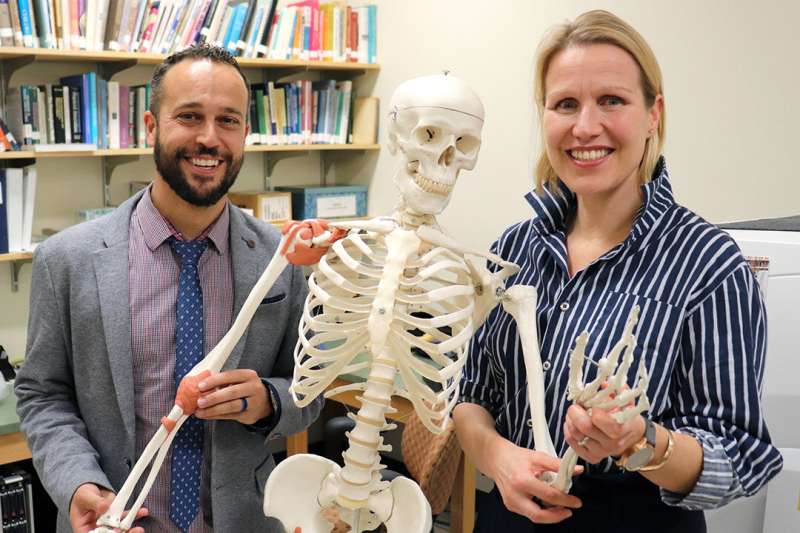Dr. Munier Nour (MD) in medicine and Dr. Saija Kontulainen (PhD) in kinesiology are collaborating on bone strength research for patients with diabetes. Credit: Alyssa Wiebe
Researchers at the University of Saskatchewan (USask) are hoping to find the answer.
A research team, jointly led by Dr. Saija Kontulainen (Ph.D.) of the College of Kinesiology and Dr. Munier Nour (MD) of the College of Medicine has focused their research on providing the first evidence of how bone strength develops in children with DM1 in comparison to their healthy peers. The team's goal is to provide new data that will help explain why bone micro-architecture and strength in children and youth with DM1 differs from those children who do not have Type 1 diabetes.
"This information is fundamentally important to improve our understanding of underpinning reasons for bone fragility in Type 1 diabetes," said Kontulainen. "Second, this information, along with the evidence of factors that can improve bone strength—such as specific exercises—will guide designs of new trials and evidence-based guidelines of diabetes care, including fracture prevention across the lifespan."
Previous studies have reported bone issues, but no one has assessed if bone micro-architecture and strength was impaired. Finding this type of evidence could help to explain why children had more fractures already during growth, said Nour.
"In recent years it has been identified that children and adults with Type 1 diabetes have impairments in bone strength and a higher risk of fracture," said Nour, a pediatric endocrinologist. "The reason for this is poorly understood and requires evaluation. Here at the University of Saskatchewan, we are uniquely poised to non-invasively evaluate bone health, using state-of-the-art high-resolution bone imaging tools."
For the past two years, the team has worked collaboratively, recruiting children and youth (ages 8-14) with DM1 from their cross-sectional study pool, local diabetes clinic, and summer camp, to collect baseline data and one-year follow-up measures.
The next step in the research project—funded by the Canadian Institutes of Health Research, Saskatchewan Health Research Foundation, and College of Medicine Research Awards—will be to examine bone structure and density in fine detail using high-resolution peripheral quantitative computer tomography (HR-pQCT) scanning and computational engineering tools, in order to define bone strength.
They will also measure growth (height and body mass), assess maturity, muscle performance and image muscle properties, as well as document hormones and growth factors from blood samples taken in the clinic and monitor nutrition (with a questionnaire) and physical activity (using activity monitors).
Over the next few years, they hope to be able to guide longer-term follow-up studies and interventions to optimize bone strength development and help prevent fractures in children with Type 1 diabetes.
Kontulainen earned her bachelor's, master's and Ph.D. back home in Finland, before coming to Canada in 2003 to conduct her post-doc research at UBC.
She said she then came to USask because of its renowned and unique longitudinal bone growth and development studies, and for the opportunity to learn from and work with experts and pioneers in the field such as Professor Emeritus Dr. Don Bailey (Ph.D.), Professor Emeritus Dr. Bob Faulkner (Ph.D.) and fellow kinesiology researcher Dr. Adam Baxter-Jones (Ph.D.).
"I have always loved to play team sports," said Kontulainen, whose training in advanced imaging brought new expertise to this highly talented team and has helped contribute to their findings. "It is similarly inspirational, fun and powerful to work together in research teams with patient/family advisors, health-care providers and decision makers, trainees and scientists from different disciplines to create new evidence and solutions for problems we all care about."
Provided by University of Saskatchewan






















